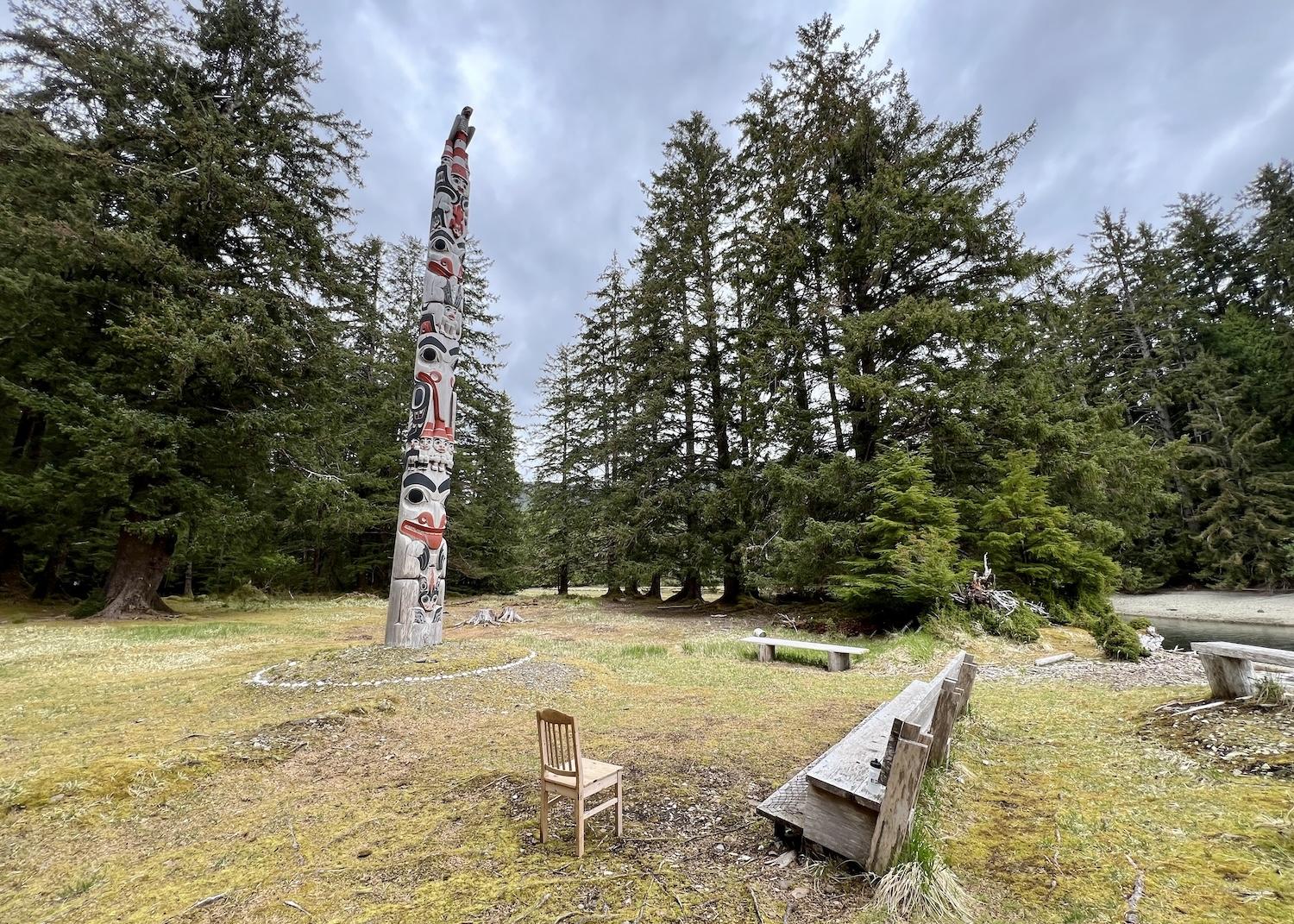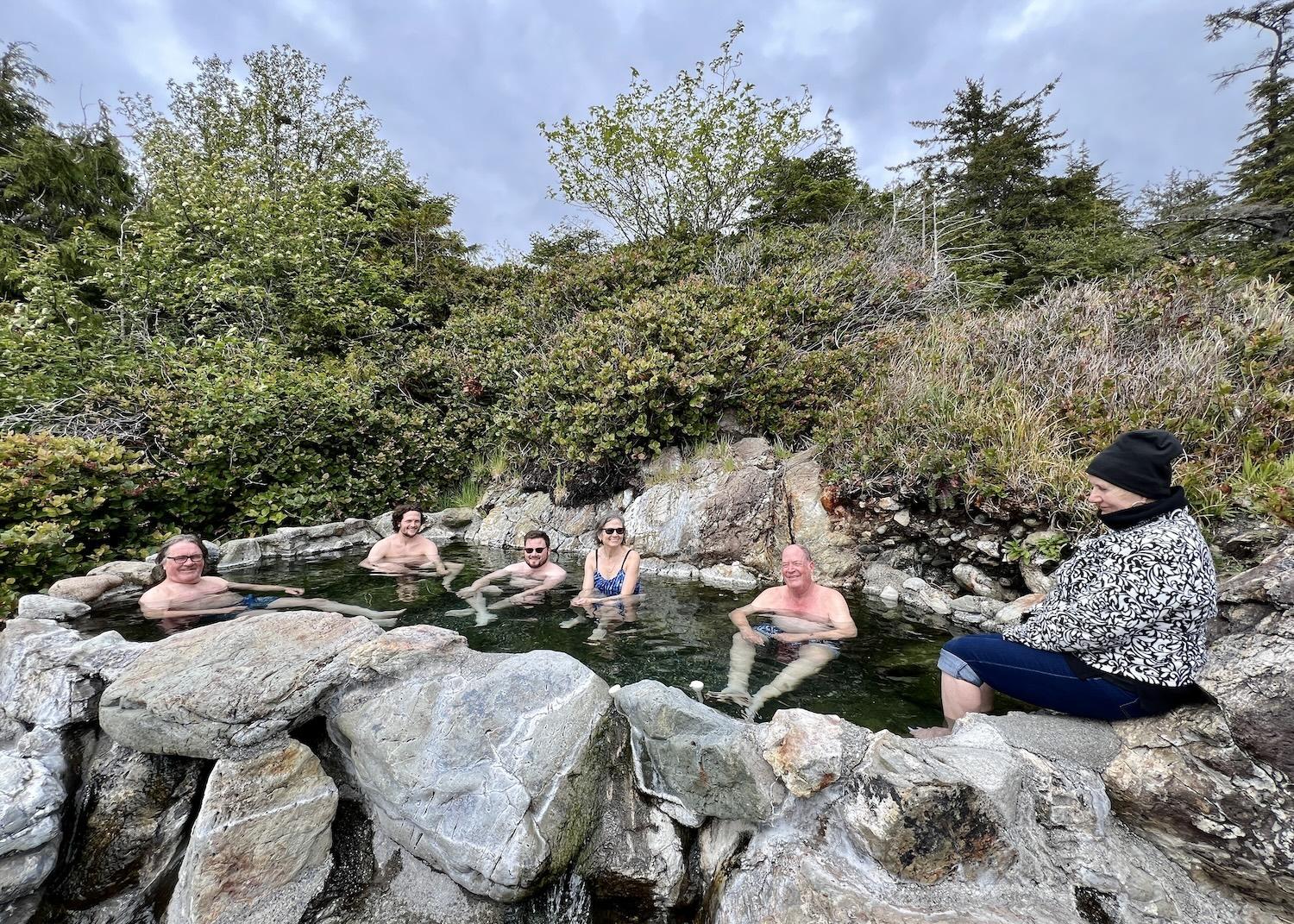“Welcome, family,” captain James Cowpar said as he nosed his boat onto the rocky shore of Athlii Gwaii (Lyell Island) at Hlk'yah G̱awG̱a (Windy Bay) in northern British Columbia. It had taken three hours by ferry, van and boat to get to this Parks Canada place with the triple-barrelled name — Gwaii Haanas National Park Reserve, National Marine Conservation Area Reserve, and Haida Heritage Site.
Nine of us hopped off to meet Haida Watchmen Gordon Russ and Reg Wesley. After introductions, we followed a shell path past the men’s cabin to a deluxe outhouse in the woods with a composting toilet. We made small talk for a bit — hearing how 84-year-old Russ just got new dentures and “got his eyes done” — and then gathered under a 42-foot monumental pole.
In Haida tradition, monumental poles are carved, danced and raised and then become living members of the community that tell stories and history. The Watchmen invited Shane “Tuna” Bell to do the honors.

The Gwaii Haanas Legacy Pole stands at Windy Bay in northern British Columbia/Jennifer Bain
A cultural guide on our “storytelling adventure” with Haida Style Expeditions, Bell explained that the Gwaii Haanas Legacy Pole was raised in 2013 to honor the 20th anniversary of the Gwaii Haanas Agreement, the cornerstone of a ground-breaking cooperative management relationship between the Haida Nation and the Government of Canada.
Carver Jaalen Edenshaw’s “Land, Sea, People” theme was inspired by the connections between the Haida Nation and all those who have cared for Gwaii Haanas since 1985 when the community blockaded logging trucks to stop the clearcutting of old growth forests.
The eagle at the top of the pole and sculpin at the bottom represent the pledge to protect Gwaii Haanas from sea floor to mountain top. Three Watchmen honor those who have watched over things in the past and present, while “5 Good People Standing Together” is a nod to the protesters. The sea wolf-life Wasco is a supernatural being. So is Sacred One Standing and Moving, who honors the impact a magnitude 7.7 earthquake had on Hotspring Island, another place of great cultural importance to the Haida that we would visit next.

Shane "Tuna" Bell, with Haida Style Expeditions, details the parts of the Gwaii Haanas Legacy Pole/Jennifer Bain
Near the top of the pole is one complex carving with a dog (representing archaeological finds that show humans have been here for 14,000 years), a pine marten (who sounds the alarm before earthquakes) and a visitor (representing people who come to see this treasured place).
“That’s you guys — you made it on the pole, too,” Bell said with a smile before turning to Russ. ““Did I miss anything Gordie?”
“Nope you pretty much got everything,” replied the Watchman who has been a halibut fisherman, logger and logging camp rigger and now raises most of the poles on Haida Gwaii. “You did good work there, Tuna.”

At Hlk'yah G̱awG̱a (Windy Bay) — one of the Haida Watchmen Sites in Gwaii Haanas — raking pine cones keeps things looking tidy/Jennifer Bain
Russ and Wesley — dressed in hoodies, fleece jackets, ball caps and beanies — weren’t wearing special Watchmen hats like on the pole. But they were following a long tradition of watchmen standing sentinel over Haida villages to warn of approaching enemies.
Today, the Haida Gwaii Watchmen is a program managed by the Council of the Haida Nation with financial support from Parks Canada. From May to October, Haida men and women live at five remote ancestral village sites to protect the natural and cultural heritage.
Watchmen may share their knowledge, stories, songs, dances and traditional foods, but they don’t have to interact with the visitors who can only visit with approved tour operators.

A Bald Eagle hunts for food at G̱andll K’in Gwaay.yaay (Hotspring Island)/Jennifer Bain
Haida Gwaii ("Islands of the People") is the ancestral territory of the Haida Nation. This storm-battered archipelago of 150 rocky islands and moss-covered rainforests is off the west coast of B.C. near Alaska’s Inside Passage. Nicknamed Canada’s Galapagos for its diverse plants and animals, Haida Gwaii is full of Sitka black-tailed deer, Bald Eagles and ravens.
Our hosts shared that Bell and Russ are part of the Eagle clan, while Wesley belongs to the Raven clan.
I arrived in Haida Gwaii in May, a month after the B.C. government officially recognized its Aboriginal title in a first-of-its kind agreement with the Council of the Haida Nation. It was my second visit and the first time I drove myself around and began to make sense of the geography.

At the Haida Watchmen site in Windy Bay, the outhouse with composting toilet is a thing of beauty/Jennifer Bain
Two main islands — Graham and Moresby — are connected by a 20-minute ferry. From Vancouver, I flew to Sandspit on Moresby, but there’s also an airport in Masset on Graham. I divided my nights between Hekate’s Retreat on Sandspit (who graciously loaned me a car since all the rentals were taken) and the Haida House at Tllaal on Graham. You can only get to Gwaii Haanas ("Islands of Beauty") by boat or floatplane, and last year just 2,792 people visited — 510 independently and 2,282 with tour operators.
On my last visit, a trip to Gwaii Haanas was scuttled by wind. This time Mother Nature co-operated on my 11-hour day with Cowpar — whose Haida name is Sk’aal Ts’iid (Flicker Bird) — and the tour company he co-owns with his twin Shawn.
"I'm going to call you family today because we're all one," said Cowpar. One of the six guiding principles of Haida culture is interconnectedness — "everything depends upon everything else." Another is respect — "we respect each other and all living things."

James Cowpar, co-owner of Haida Style Expeditions, takes guests to G̱andll K’in Gwaay.yaay (Hotspring Island) and other Haida Watchmen sites/Jennifer Bain
After learning about the monumental pole, we walked over to the longhouse. Formally called “Looking Around and Blinking House,” it was built to house people during the 1985 logging blockade but is on its last legs and now only used for storage.
In Bell's words: “It’s called the Blinking Eye House and it’s called that because when they had this standoff it was pretty intense. And it was almost like they were having a staring contest. Whoever blinks first loses.”
“I guess the loggers blinked first, eh?” chuckled Russ.

James Cowpar helps guests over a creek at Windy Bay, a Haida Watchmen Site in Gwaii Haanas/Jennifer Bain
We didn’t overstay our welcome, but said a grateful goodbye before crossing Windy Bay Creek in an ingenious boat and trolley system.
Walking to a giant Sitka spruce that’s nearly 900 years old, we saw a deer fence protecting the precious forest understory, a hungry deer intent on getting at the greenery, and a deer skull.
Scrambling over a rocky shoreline, we reunited with our captain.

Once the site of logging protests, Lyell Island now protects trees like this giant Sitka spruce in Windy Bay/Jennifer Bain
“Welcome aboard everyone,” said Cowpar. “How was the Big Tree? Is it still standing?”
He had been busy grilling deer, chinook salmon and halibut that he had harvested himself.
The food made me think of the Haida Gwaii Pledge. “I will respect Haida Gwaii and Haida Ways of Being during my visit,” I had pledged after watching an online orientation video. Among other things, I promised to take only what I needed to feed myself each day, and only what was given to me, leaving behind rocks, feathers, sand and artifacts. Of course, national park regulars already know to take nothing but photographs from protected places.

On my day-long boat trip to Gwaii Haanas, James Cowpar served us deer, salmon and halibut that he harvested himself/Jennifer Bain
Our bellies full, we traveled on to G̱andll K’in Gwaay.yaay (Hotspring Island).
This time Cowpar deposited us on a back beach and we followed a trail through old growth forest, mindful that Watchmen aren’t tour guides and that the program aims to “get families down here to experience nature and put the phones down.”
We only met one Watchman — not his significant other — who pointed out the bathroom and asked us to avoid tracking gravel onto the boardwalks or into the shower area. “You have one hour once you get down there,” he said. “Is everybody going in the pool? Like I said, stay together as a group and other than that, have fun.”

At a pool on Hotspring Island in May, Shane "Tuna" Bell takes in views of Juan Perez Sound/Jennifer Bain
This island traditionally provided abundant food and healing waters to the Haida. The source of the water isn’t known, but the springs seep from at least 26 small vents, at temperatures ranging from 89F to 170F. That’s too hot for anything but my feet.
“Oh that is pretty toasty — goodness,” said a fellow traveler as she slipped into the largest pool. “It’s warmer than I thought it would be. That’s great.”
The original pools drained after that 2012 earthquake. Three newly rebuilt ones reopened in 2017. This being a Parks Canada place, there was a stern notice warning that hot pools encourage bacterial growth that can cause eye, ear and skin infections. “If you choose to use these pools,” the bulletin read, “please be aware that you do so at your own risk.”

While exploring Gwaii Haanas in May, a group of Americans and Canadians soak in hot springs at Hotspring Island/Jennifer Bain
We took our chances and the only bad thing that happened during our hour was a sprinkling of rain.
With views of Juan Perez Sound, you can sometimes see SGaana (killer whales) or globally rare seabirds such as Cassin’s Auklets or Ancient Murrelets from the pools. After dark, a rare maternity colony of Keen’s long-eared bats comes out.
We had no such wildlife luck but watched an eagle fishing for two of its offspring. Then, while leading us back through the woods to the boat, Bell picked up something black and yellow. It was my first cyanide millipede.

Shane "Tuna" Bell carefully shows off a cyanide millipede that he found in the forest on Hotspring Island in Gwaii Haanas/Jennifer Bain
Also called yellow-spotted or almond-scented millipedes, they coil up and secrete hydrogen cyanide when threatened. This chemical warfare can kill birds and rodents but not humans — though it can sting eyes, mouths and noses.
More importantly, Sitka spruce-loving cyanide millipedes devour leaf litter then excrete rich nutrient loads.
On a day filled with lessons, this creature that really did smell faintly nutty perfectly illustrated the Haida belief in interconnectedness — "everything depends on everything else." Mindful of the need to respect all living creatures, we quickly returned this unsung hero of healthy ecosystems to the forest floor.

Sitka black-tailed deer, an introduced species, abound in Haida Gwaii. This one was spotted at Windy Bay in Gwaii Haanas/Jennifer Bain



 Support Essential Coverage of Essential Places
Support Essential Coverage of Essential Places






